Mental Health Illness and Their Lived Experience
VerifiedAdded on 2022/08/15
|7
|1897
|12
AI Summary
Contribute Materials
Your contribution can guide someone’s learning journey. Share your
documents today.
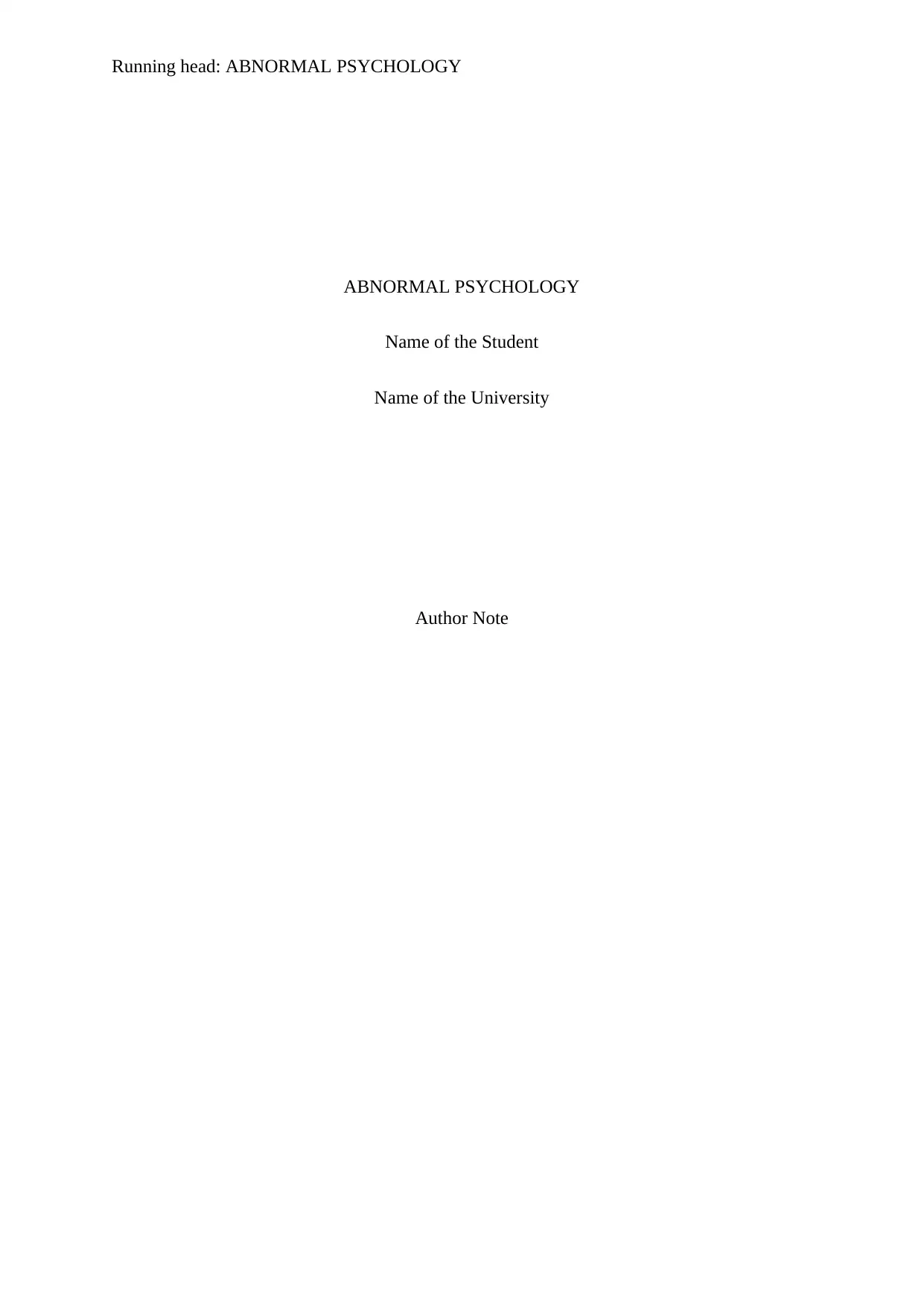
Running head: ABNORMAL PSYCHOLOGY
ABNORMAL PSYCHOLOGY
Name of the Student
Name of the University
Author Note
ABNORMAL PSYCHOLOGY
Name of the Student
Name of the University
Author Note
Secure Best Marks with AI Grader
Need help grading? Try our AI Grader for instant feedback on your assignments.
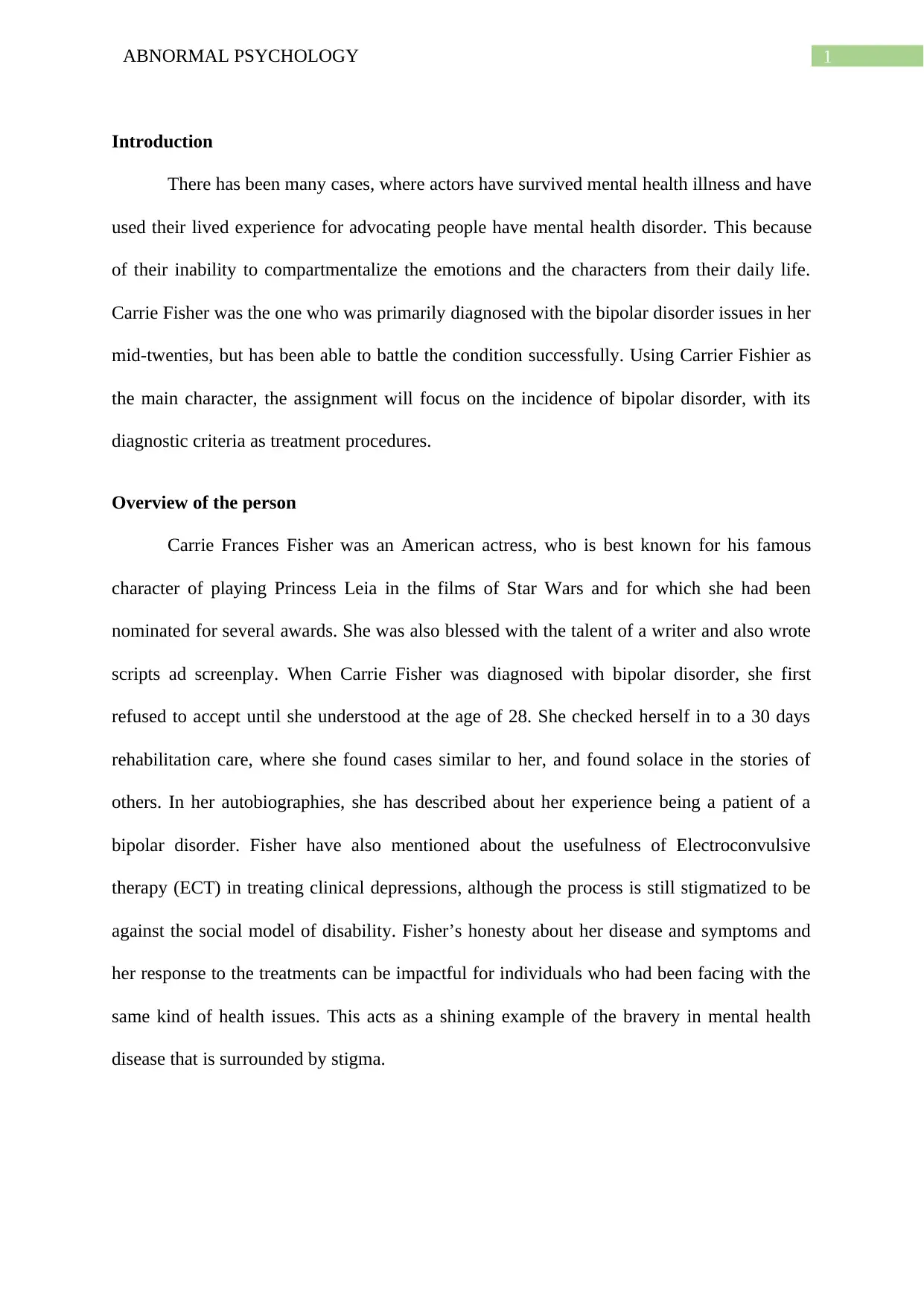
1ABNORMAL PSYCHOLOGY
Introduction
There has been many cases, where actors have survived mental health illness and have
used their lived experience for advocating people have mental health disorder. This because
of their inability to compartmentalize the emotions and the characters from their daily life.
Carrie Fisher was the one who was primarily diagnosed with the bipolar disorder issues in her
mid-twenties, but has been able to battle the condition successfully. Using Carrier Fishier as
the main character, the assignment will focus on the incidence of bipolar disorder, with its
diagnostic criteria as treatment procedures.
Overview of the person
Carrie Frances Fisher was an American actress, who is best known for his famous
character of playing Princess Leia in the films of Star Wars and for which she had been
nominated for several awards. She was also blessed with the talent of a writer and also wrote
scripts ad screenplay. When Carrie Fisher was diagnosed with bipolar disorder, she first
refused to accept until she understood at the age of 28. She checked herself in to a 30 days
rehabilitation care, where she found cases similar to her, and found solace in the stories of
others. In her autobiographies, she has described about her experience being a patient of a
bipolar disorder. Fisher have also mentioned about the usefulness of Electroconvulsive
therapy (ECT) in treating clinical depressions, although the process is still stigmatized to be
against the social model of disability. Fisher’s honesty about her disease and symptoms and
her response to the treatments can be impactful for individuals who had been facing with the
same kind of health issues. This acts as a shining example of the bravery in mental health
disease that is surrounded by stigma.
Introduction
There has been many cases, where actors have survived mental health illness and have
used their lived experience for advocating people have mental health disorder. This because
of their inability to compartmentalize the emotions and the characters from their daily life.
Carrie Fisher was the one who was primarily diagnosed with the bipolar disorder issues in her
mid-twenties, but has been able to battle the condition successfully. Using Carrier Fishier as
the main character, the assignment will focus on the incidence of bipolar disorder, with its
diagnostic criteria as treatment procedures.
Overview of the person
Carrie Frances Fisher was an American actress, who is best known for his famous
character of playing Princess Leia in the films of Star Wars and for which she had been
nominated for several awards. She was also blessed with the talent of a writer and also wrote
scripts ad screenplay. When Carrie Fisher was diagnosed with bipolar disorder, she first
refused to accept until she understood at the age of 28. She checked herself in to a 30 days
rehabilitation care, where she found cases similar to her, and found solace in the stories of
others. In her autobiographies, she has described about her experience being a patient of a
bipolar disorder. Fisher have also mentioned about the usefulness of Electroconvulsive
therapy (ECT) in treating clinical depressions, although the process is still stigmatized to be
against the social model of disability. Fisher’s honesty about her disease and symptoms and
her response to the treatments can be impactful for individuals who had been facing with the
same kind of health issues. This acts as a shining example of the bravery in mental health
disease that is surrounded by stigma.
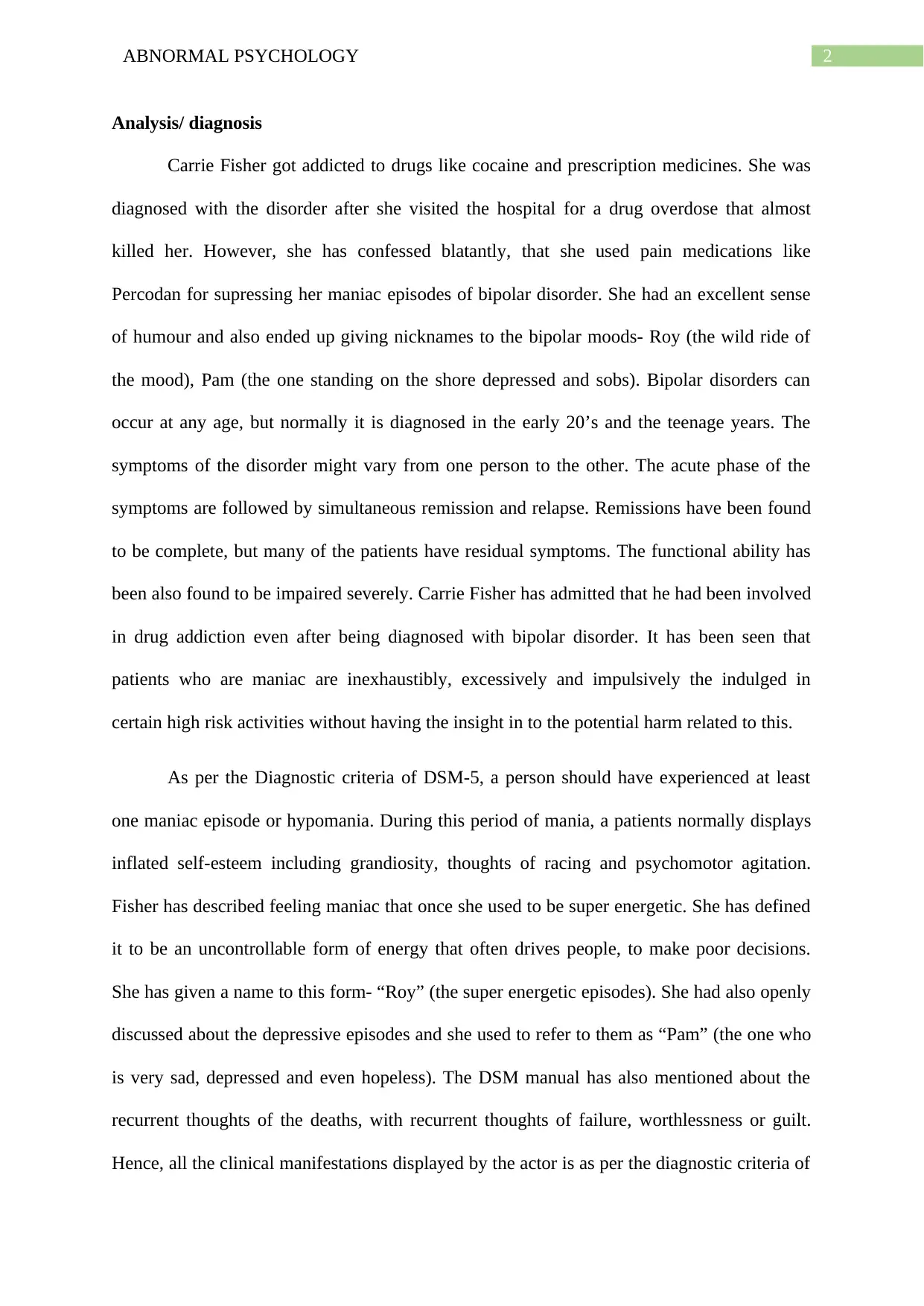
2ABNORMAL PSYCHOLOGY
Analysis/ diagnosis
Carrie Fisher got addicted to drugs like cocaine and prescription medicines. She was
diagnosed with the disorder after she visited the hospital for a drug overdose that almost
killed her. However, she has confessed blatantly, that she used pain medications like
Percodan for supressing her maniac episodes of bipolar disorder. She had an excellent sense
of humour and also ended up giving nicknames to the bipolar moods- Roy (the wild ride of
the mood), Pam (the one standing on the shore depressed and sobs). Bipolar disorders can
occur at any age, but normally it is diagnosed in the early 20’s and the teenage years. The
symptoms of the disorder might vary from one person to the other. The acute phase of the
symptoms are followed by simultaneous remission and relapse. Remissions have been found
to be complete, but many of the patients have residual symptoms. The functional ability has
been also found to be impaired severely. Carrie Fisher has admitted that he had been involved
in drug addiction even after being diagnosed with bipolar disorder. It has been seen that
patients who are maniac are inexhaustibly, excessively and impulsively the indulged in
certain high risk activities without having the insight in to the potential harm related to this.
As per the Diagnostic criteria of DSM-5, a person should have experienced at least
one maniac episode or hypomania. During this period of mania, a patients normally displays
inflated self-esteem including grandiosity, thoughts of racing and psychomotor agitation.
Fisher has described feeling maniac that once she used to be super energetic. She has defined
it to be an uncontrollable form of energy that often drives people, to make poor decisions.
She has given a name to this form- “Roy” (the super energetic episodes). She had also openly
discussed about the depressive episodes and she used to refer to them as “Pam” (the one who
is very sad, depressed and even hopeless). The DSM manual has also mentioned about the
recurrent thoughts of the deaths, with recurrent thoughts of failure, worthlessness or guilt.
Hence, all the clinical manifestations displayed by the actor is as per the diagnostic criteria of
Analysis/ diagnosis
Carrie Fisher got addicted to drugs like cocaine and prescription medicines. She was
diagnosed with the disorder after she visited the hospital for a drug overdose that almost
killed her. However, she has confessed blatantly, that she used pain medications like
Percodan for supressing her maniac episodes of bipolar disorder. She had an excellent sense
of humour and also ended up giving nicknames to the bipolar moods- Roy (the wild ride of
the mood), Pam (the one standing on the shore depressed and sobs). Bipolar disorders can
occur at any age, but normally it is diagnosed in the early 20’s and the teenage years. The
symptoms of the disorder might vary from one person to the other. The acute phase of the
symptoms are followed by simultaneous remission and relapse. Remissions have been found
to be complete, but many of the patients have residual symptoms. The functional ability has
been also found to be impaired severely. Carrie Fisher has admitted that he had been involved
in drug addiction even after being diagnosed with bipolar disorder. It has been seen that
patients who are maniac are inexhaustibly, excessively and impulsively the indulged in
certain high risk activities without having the insight in to the potential harm related to this.
As per the Diagnostic criteria of DSM-5, a person should have experienced at least
one maniac episode or hypomania. During this period of mania, a patients normally displays
inflated self-esteem including grandiosity, thoughts of racing and psychomotor agitation.
Fisher has described feeling maniac that once she used to be super energetic. She has defined
it to be an uncontrollable form of energy that often drives people, to make poor decisions.
She has given a name to this form- “Roy” (the super energetic episodes). She had also openly
discussed about the depressive episodes and she used to refer to them as “Pam” (the one who
is very sad, depressed and even hopeless). The DSM manual has also mentioned about the
recurrent thoughts of the deaths, with recurrent thoughts of failure, worthlessness or guilt.
Hence, all the clinical manifestations displayed by the actor is as per the diagnostic criteria of
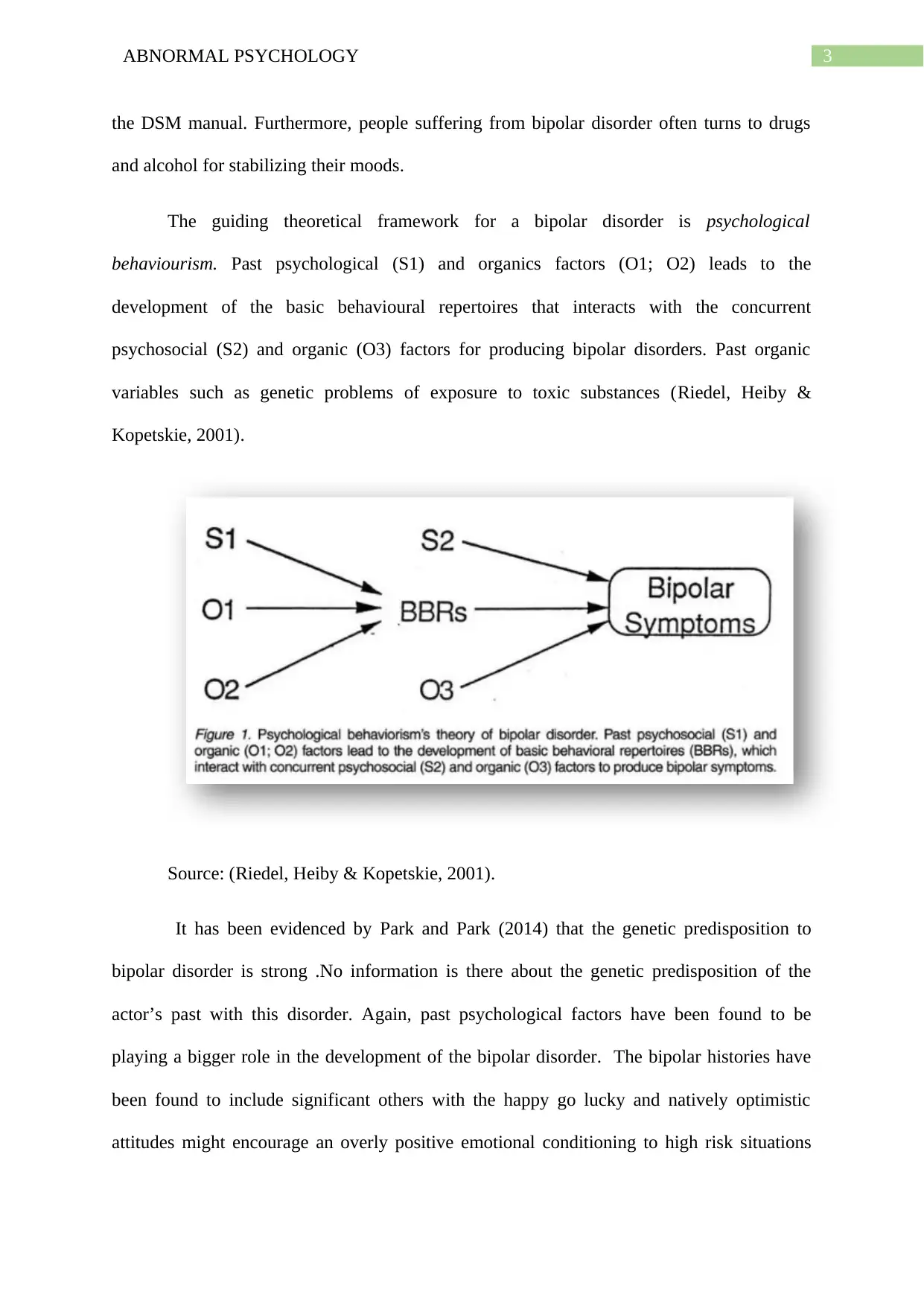
3ABNORMAL PSYCHOLOGY
the DSM manual. Furthermore, people suffering from bipolar disorder often turns to drugs
and alcohol for stabilizing their moods.
The guiding theoretical framework for a bipolar disorder is psychological
behaviourism. Past psychological (S1) and organics factors (O1; O2) leads to the
development of the basic behavioural repertoires that interacts with the concurrent
psychosocial (S2) and organic (O3) factors for producing bipolar disorders. Past organic
variables such as genetic problems of exposure to toxic substances (Riedel, Heiby &
Kopetskie, 2001).
Source: (Riedel, Heiby & Kopetskie, 2001).
It has been evidenced by Park and Park (2014) that the genetic predisposition to
bipolar disorder is strong .No information is there about the genetic predisposition of the
actor’s past with this disorder. Again, past psychological factors have been found to be
playing a bigger role in the development of the bipolar disorder. The bipolar histories have
been found to include significant others with the happy go lucky and natively optimistic
attitudes might encourage an overly positive emotional conditioning to high risk situations
the DSM manual. Furthermore, people suffering from bipolar disorder often turns to drugs
and alcohol for stabilizing their moods.
The guiding theoretical framework for a bipolar disorder is psychological
behaviourism. Past psychological (S1) and organics factors (O1; O2) leads to the
development of the basic behavioural repertoires that interacts with the concurrent
psychosocial (S2) and organic (O3) factors for producing bipolar disorders. Past organic
variables such as genetic problems of exposure to toxic substances (Riedel, Heiby &
Kopetskie, 2001).
Source: (Riedel, Heiby & Kopetskie, 2001).
It has been evidenced by Park and Park (2014) that the genetic predisposition to
bipolar disorder is strong .No information is there about the genetic predisposition of the
actor’s past with this disorder. Again, past psychological factors have been found to be
playing a bigger role in the development of the bipolar disorder. The bipolar histories have
been found to include significant others with the happy go lucky and natively optimistic
attitudes might encourage an overly positive emotional conditioning to high risk situations
Secure Best Marks with AI Grader
Need help grading? Try our AI Grader for instant feedback on your assignments.
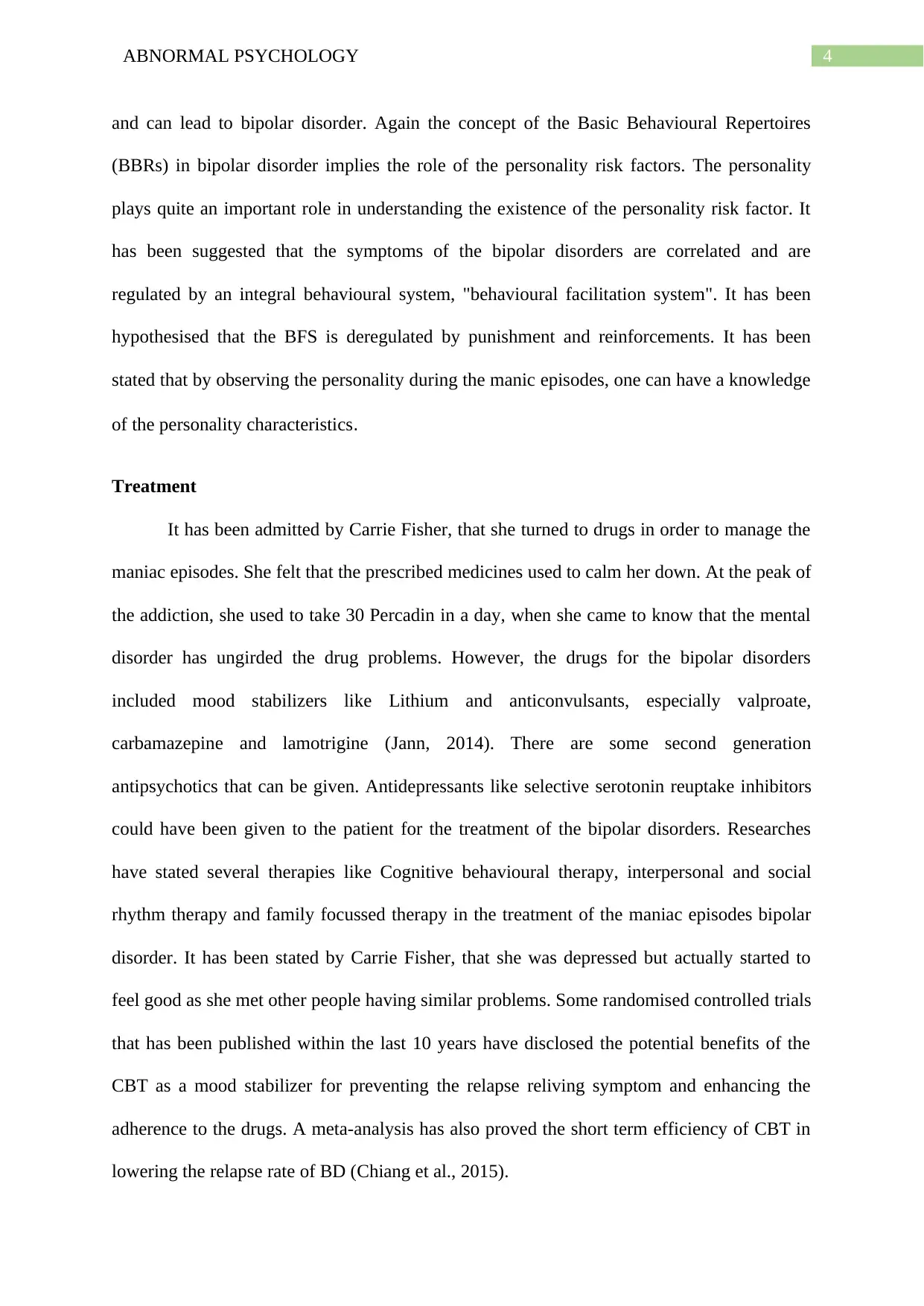
4ABNORMAL PSYCHOLOGY
and can lead to bipolar disorder. Again the concept of the Basic Behavioural Repertoires
(BBRs) in bipolar disorder implies the role of the personality risk factors. The personality
plays quite an important role in understanding the existence of the personality risk factor. It
has been suggested that the symptoms of the bipolar disorders are correlated and are
regulated by an integral behavioural system, "behavioural facilitation system". It has been
hypothesised that the BFS is deregulated by punishment and reinforcements. It has been
stated that by observing the personality during the manic episodes, one can have a knowledge
of the personality characteristics.
Treatment
It has been admitted by Carrie Fisher, that she turned to drugs in order to manage the
maniac episodes. She felt that the prescribed medicines used to calm her down. At the peak of
the addiction, she used to take 30 Percadin in a day, when she came to know that the mental
disorder has ungirded the drug problems. However, the drugs for the bipolar disorders
included mood stabilizers like Lithium and anticonvulsants, especially valproate,
carbamazepine and lamotrigine (Jann, 2014). There are some second generation
antipsychotics that can be given. Antidepressants like selective serotonin reuptake inhibitors
could have been given to the patient for the treatment of the bipolar disorders. Researches
have stated several therapies like Cognitive behavioural therapy, interpersonal and social
rhythm therapy and family focussed therapy in the treatment of the maniac episodes bipolar
disorder. It has been stated by Carrie Fisher, that she was depressed but actually started to
feel good as she met other people having similar problems. Some randomised controlled trials
that has been published within the last 10 years have disclosed the potential benefits of the
CBT as a mood stabilizer for preventing the relapse reliving symptom and enhancing the
adherence to the drugs. A meta-analysis has also proved the short term efficiency of CBT in
lowering the relapse rate of BD (Chiang et al., 2015).
and can lead to bipolar disorder. Again the concept of the Basic Behavioural Repertoires
(BBRs) in bipolar disorder implies the role of the personality risk factors. The personality
plays quite an important role in understanding the existence of the personality risk factor. It
has been suggested that the symptoms of the bipolar disorders are correlated and are
regulated by an integral behavioural system, "behavioural facilitation system". It has been
hypothesised that the BFS is deregulated by punishment and reinforcements. It has been
stated that by observing the personality during the manic episodes, one can have a knowledge
of the personality characteristics.
Treatment
It has been admitted by Carrie Fisher, that she turned to drugs in order to manage the
maniac episodes. She felt that the prescribed medicines used to calm her down. At the peak of
the addiction, she used to take 30 Percadin in a day, when she came to know that the mental
disorder has ungirded the drug problems. However, the drugs for the bipolar disorders
included mood stabilizers like Lithium and anticonvulsants, especially valproate,
carbamazepine and lamotrigine (Jann, 2014). There are some second generation
antipsychotics that can be given. Antidepressants like selective serotonin reuptake inhibitors
could have been given to the patient for the treatment of the bipolar disorders. Researches
have stated several therapies like Cognitive behavioural therapy, interpersonal and social
rhythm therapy and family focussed therapy in the treatment of the maniac episodes bipolar
disorder. It has been stated by Carrie Fisher, that she was depressed but actually started to
feel good as she met other people having similar problems. Some randomised controlled trials
that has been published within the last 10 years have disclosed the potential benefits of the
CBT as a mood stabilizer for preventing the relapse reliving symptom and enhancing the
adherence to the drugs. A meta-analysis has also proved the short term efficiency of CBT in
lowering the relapse rate of BD (Chiang et al., 2015).
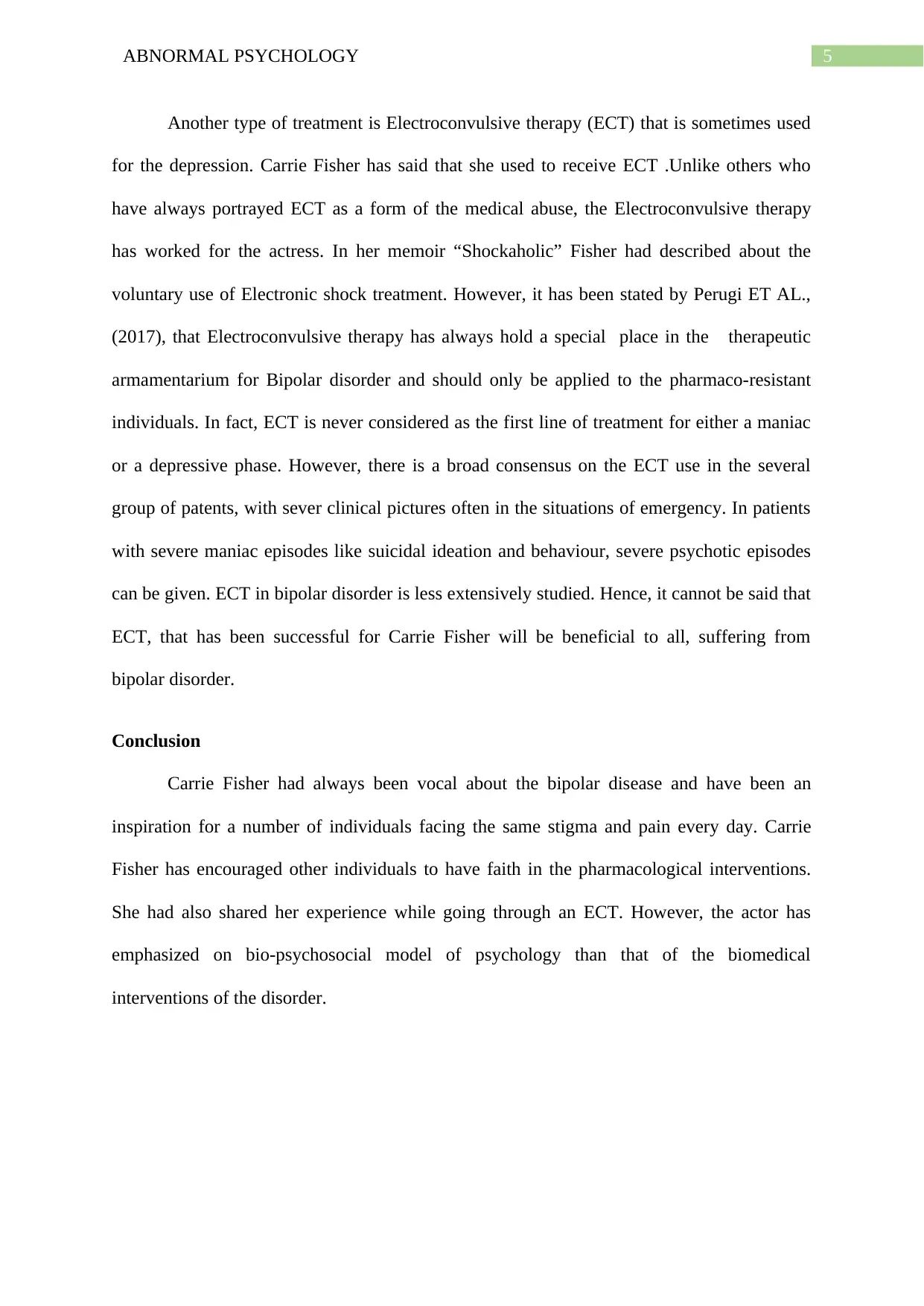
5ABNORMAL PSYCHOLOGY
Another type of treatment is Electroconvulsive therapy (ECT) that is sometimes used
for the depression. Carrie Fisher has said that she used to receive ECT .Unlike others who
have always portrayed ECT as a form of the medical abuse, the Electroconvulsive therapy
has worked for the actress. In her memoir “Shockaholic” Fisher had described about the
voluntary use of Electronic shock treatment. However, it has been stated by Perugi ET AL.,
(2017), that Electroconvulsive therapy has always hold a special place in the therapeutic
armamentarium for Bipolar disorder and should only be applied to the pharmaco-resistant
individuals. In fact, ECT is never considered as the first line of treatment for either a maniac
or a depressive phase. However, there is a broad consensus on the ECT use in the several
group of patents, with sever clinical pictures often in the situations of emergency. In patients
with severe maniac episodes like suicidal ideation and behaviour, severe psychotic episodes
can be given. ECT in bipolar disorder is less extensively studied. Hence, it cannot be said that
ECT, that has been successful for Carrie Fisher will be beneficial to all, suffering from
bipolar disorder.
Conclusion
Carrie Fisher had always been vocal about the bipolar disease and have been an
inspiration for a number of individuals facing the same stigma and pain every day. Carrie
Fisher has encouraged other individuals to have faith in the pharmacological interventions.
She had also shared her experience while going through an ECT. However, the actor has
emphasized on bio-psychosocial model of psychology than that of the biomedical
interventions of the disorder.
Another type of treatment is Electroconvulsive therapy (ECT) that is sometimes used
for the depression. Carrie Fisher has said that she used to receive ECT .Unlike others who
have always portrayed ECT as a form of the medical abuse, the Electroconvulsive therapy
has worked for the actress. In her memoir “Shockaholic” Fisher had described about the
voluntary use of Electronic shock treatment. However, it has been stated by Perugi ET AL.,
(2017), that Electroconvulsive therapy has always hold a special place in the therapeutic
armamentarium for Bipolar disorder and should only be applied to the pharmaco-resistant
individuals. In fact, ECT is never considered as the first line of treatment for either a maniac
or a depressive phase. However, there is a broad consensus on the ECT use in the several
group of patents, with sever clinical pictures often in the situations of emergency. In patients
with severe maniac episodes like suicidal ideation and behaviour, severe psychotic episodes
can be given. ECT in bipolar disorder is less extensively studied. Hence, it cannot be said that
ECT, that has been successful for Carrie Fisher will be beneficial to all, suffering from
bipolar disorder.
Conclusion
Carrie Fisher had always been vocal about the bipolar disease and have been an
inspiration for a number of individuals facing the same stigma and pain every day. Carrie
Fisher has encouraged other individuals to have faith in the pharmacological interventions.
She had also shared her experience while going through an ECT. However, the actor has
emphasized on bio-psychosocial model of psychology than that of the biomedical
interventions of the disorder.
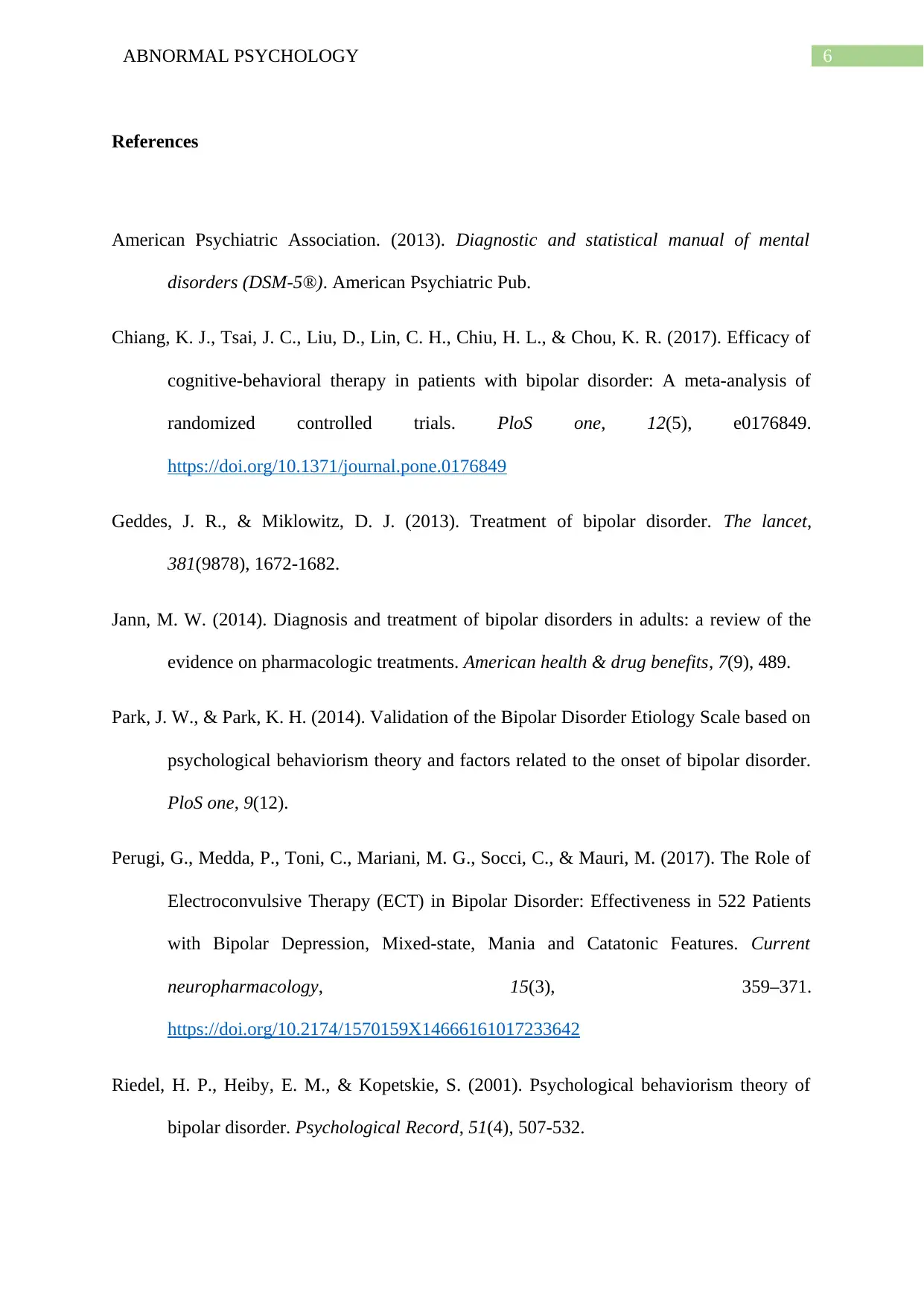
6ABNORMAL PSYCHOLOGY
References
American Psychiatric Association. (2013). Diagnostic and statistical manual of mental
disorders (DSM-5®). American Psychiatric Pub.
Chiang, K. J., Tsai, J. C., Liu, D., Lin, C. H., Chiu, H. L., & Chou, K. R. (2017). Efficacy of
cognitive-behavioral therapy in patients with bipolar disorder: A meta-analysis of
randomized controlled trials. PloS one, 12(5), e0176849.
https://doi.org/10.1371/journal.pone.0176849
Geddes, J. R., & Miklowitz, D. J. (2013). Treatment of bipolar disorder. The lancet,
381(9878), 1672-1682.
Jann, M. W. (2014). Diagnosis and treatment of bipolar disorders in adults: a review of the
evidence on pharmacologic treatments. American health & drug benefits, 7(9), 489.
Park, J. W., & Park, K. H. (2014). Validation of the Bipolar Disorder Etiology Scale based on
psychological behaviorism theory and factors related to the onset of bipolar disorder.
PloS one, 9(12).
Perugi, G., Medda, P., Toni, C., Mariani, M. G., Socci, C., & Mauri, M. (2017). The Role of
Electroconvulsive Therapy (ECT) in Bipolar Disorder: Effectiveness in 522 Patients
with Bipolar Depression, Mixed-state, Mania and Catatonic Features. Current
neuropharmacology, 15(3), 359–371.
https://doi.org/10.2174/1570159X14666161017233642
Riedel, H. P., Heiby, E. M., & Kopetskie, S. (2001). Psychological behaviorism theory of
bipolar disorder. Psychological Record, 51(4), 507-532.
References
American Psychiatric Association. (2013). Diagnostic and statistical manual of mental
disorders (DSM-5®). American Psychiatric Pub.
Chiang, K. J., Tsai, J. C., Liu, D., Lin, C. H., Chiu, H. L., & Chou, K. R. (2017). Efficacy of
cognitive-behavioral therapy in patients with bipolar disorder: A meta-analysis of
randomized controlled trials. PloS one, 12(5), e0176849.
https://doi.org/10.1371/journal.pone.0176849
Geddes, J. R., & Miklowitz, D. J. (2013). Treatment of bipolar disorder. The lancet,
381(9878), 1672-1682.
Jann, M. W. (2014). Diagnosis and treatment of bipolar disorders in adults: a review of the
evidence on pharmacologic treatments. American health & drug benefits, 7(9), 489.
Park, J. W., & Park, K. H. (2014). Validation of the Bipolar Disorder Etiology Scale based on
psychological behaviorism theory and factors related to the onset of bipolar disorder.
PloS one, 9(12).
Perugi, G., Medda, P., Toni, C., Mariani, M. G., Socci, C., & Mauri, M. (2017). The Role of
Electroconvulsive Therapy (ECT) in Bipolar Disorder: Effectiveness in 522 Patients
with Bipolar Depression, Mixed-state, Mania and Catatonic Features. Current
neuropharmacology, 15(3), 359–371.
https://doi.org/10.2174/1570159X14666161017233642
Riedel, H. P., Heiby, E. M., & Kopetskie, S. (2001). Psychological behaviorism theory of
bipolar disorder. Psychological Record, 51(4), 507-532.
1 out of 7
Related Documents
Your All-in-One AI-Powered Toolkit for Academic Success.
+13062052269
info@desklib.com
Available 24*7 on WhatsApp / Email
![[object Object]](/_next/static/media/star-bottom.7253800d.svg)
Unlock your academic potential
© 2024 | Zucol Services PVT LTD | All rights reserved.





